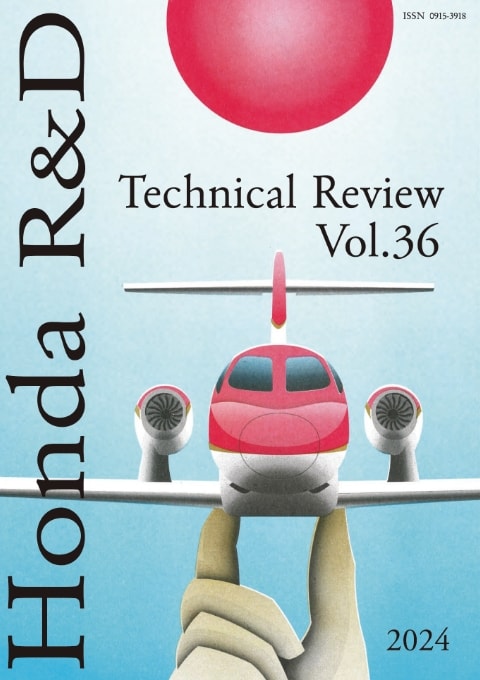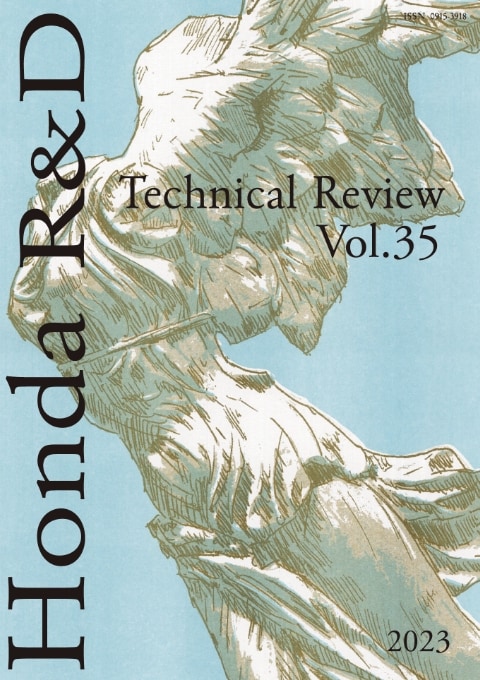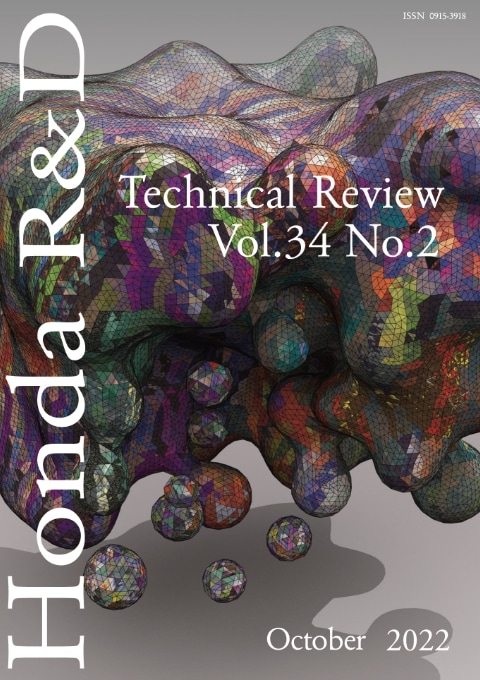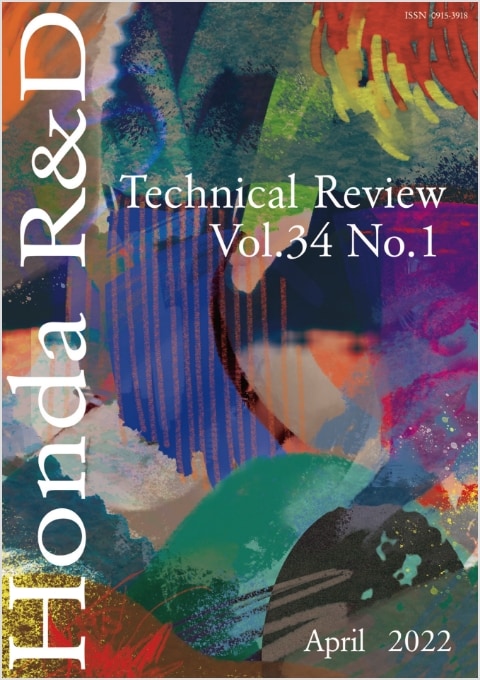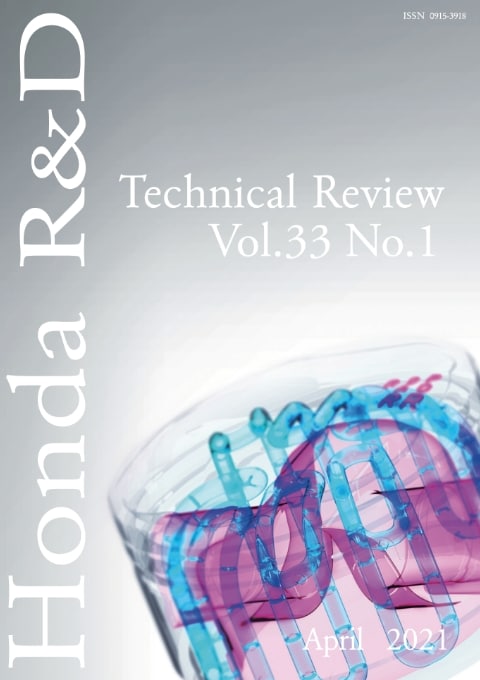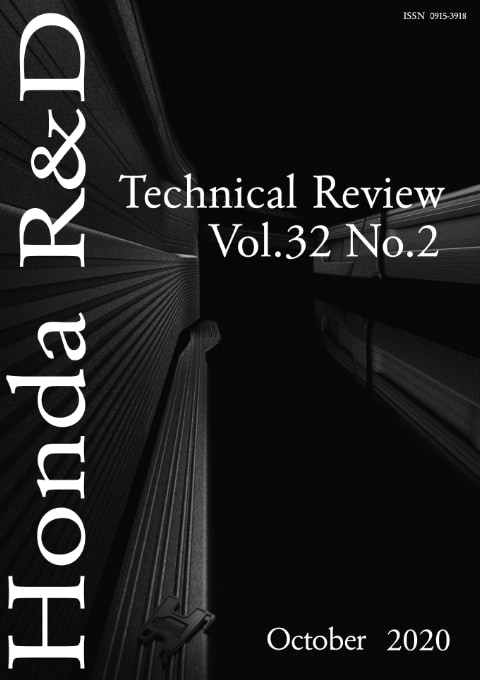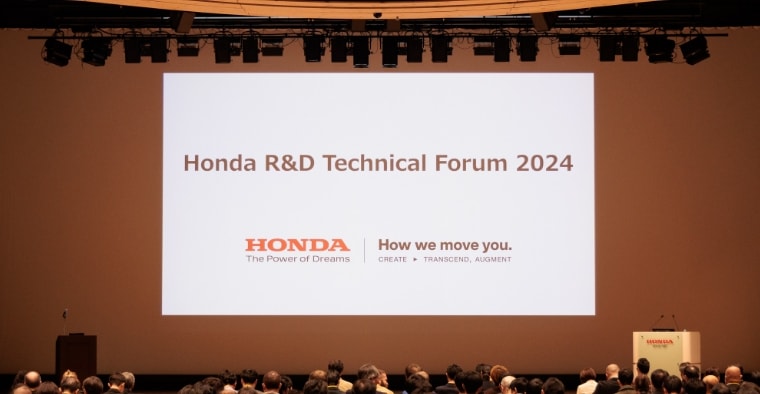Honda R&D Technical Review Vol.32 No.2
Honda R&D
Technical Review Vol.32 No.2
- “N for Work” N-VAN Design Enriches Possibilities for Life with Loading and Carrying
- Summary
The N-VAN is a microvan that as successor to the ACTY VAN represents the first full model change in 19 years. Since the time of its founding, Honda has pursued experiential value that would help enrich customers’ lives.
Honda Design refers to this as experience design and engages in vehicle design that ponders ever more deeply about the customer’s experiential value. N-VAN development was also based on this kind of thinking, and in order to reach a deeper understanding of the customer, research was done into the actual circumstances of people who work and people who engage in loading and carrying cargo. The designers themselves worked with package models and went through repeated trial and error to experience directly how different cargo would be loaded, what kinds of issues would be encountered when loading, what points people would have challenging with, and so on. As a result, it was decided that customers are of two types, those who emphasize functionality and those who also like to emphasize style in addition to functionality. First, for customers who emphasize functionality, the concept of “a tool for a life that involves loading and carrying things” was determined, with the idea that the vehicle would become like a familiar tool that is easy to work with. The base G and L grades were designed around the keywords of “a feeling of flexible usability,” “a feeling of unstressed security,” “a feeling of solid stability,” and “beautility.” With these G and L grades as a foundation, another grade called +STYLE was configured to support a world view of each customer who places importance on style in addition to functionality. With these two grades, a new standard was created for a new microvan that becomes an important tool for everyday lives that involve loading and carrying things.Maki YAMAGUCHI、Chiaki KATO、Yoshihisa YANAGIMOTO、Noriyuki ISHIDA
Details of papers - Development of 2020 CRF1100L Africa Twin
- Summary
Ever since the revival of the model name in 2016, Honda Africa Twin has been well-supported by the customers as an adventure motorcycle enjoyable on off roads as well as for touring on pavement. After four years since the initial launch in 2016, a full model change has been conducted in this project, renewing everything from the engine, frame body, suspension to the exterior, gaining more power by the increased engine displacement while reducing weight of the complete motorcycle. Accordingly realized are the more off-road friendly Africa Twin, and the Africa Twin Adventure Sports more suitable for touring with abundance of extra equipment for long, comfortable rides.
Kenji MORITA、Nozomi OKADA、Hiroshi OKAMURA、Shota SUZUKI
Details of papers - Development of Electronically-controlled Suspension System for 2020 CRF1100L Africa Twin Adventure Sports ES
- Summary
The Honda Africa Twin is a full-scale adventure model featuring off-road and touring capabilities. As a 2020-year model, we have developed the CRF1100L Africa Twin Adventure Sports ES equipped with the new electronically-controlled suspension. Four suspension modes (HARD, MID, SOFT, OFFROAD) are provided to help ensure optimum performance in the wide variety of usage from high-speed long touring with a passenger and/or luggage up to challenging off-road riding. The riding modes are designated taking into account such five parameters as the engine power, the engine brake, the clutch characteristics (DCT model only), and the ABS characteristics in addition to the suspension modes. The rider can select any mode from the handlebar switch even when riding to adjust the motorcycle characteristics to best-suit his/her desire depending on the situation and vehicle conditions.
Hiroshi OKAMURA、Tsuyoshi TSUDA、Atsushi OGAHARA
Details of papers - Cornering Lights of 2020 CRF1100L Africa Twin Adventure Sports Using Additional Light Source
- Summary
After the revision of United Nations regulations in 2013, cornering lights are permitted for motorcycles. A number of cases of cornering light applications to motorcycles are seen up until now. We have developed the cornering lights for comfortable touring, especially suitable for riding suburban roads mainly at moderate speeds, and applied to the CRF1100L Africa Twin Adventure Sports. Using the said motorcycle, we conducted studies on the three key factors in the designing of cornering lights; the setting the operating range according to the bank angle, the setting the light distribution with an additional light source, and the control of visual distraction. The operating of cornering lights is determined from the frequency of bank angles measured from actual night riding. The distribution of light from the additional light source is determined so as to illuminate the cornering direction at the same intensity as the dipped beam. Regarding the visual distraction, the cornering lights are designed so as to increase intensity gradually after turning it on until reaching 100%. A hysteresis is also set in the switching to help prevent flickering. With these measures taken, the cornering lights suitable for touring have been realized.
Tokujiro KIZAKI、Hirotaka SATO
Details of papers - Experimental Environment for Verification of Speech-based News Delivery System
- Summary
An original spoken dialogue system was developed that is capable of diverse responses to user utterances while communicating information using news articles distributed on the Internet. Most conventional spoken dialogue systems are question-and-answer types, and are not suited to communicating large amounts of information such as news articles. In addition, users are unable to interrupt news article read-aloud systems with questions. Therefore, new key technologies related to spoken dialogue systems were developed, including conversation summarization technology, a paralanguage recognizer, pause adjustment, and a speech synthesizer, and an experimental system was constructed that is capable of spoken dialogue in Japanese using news articles distributed in real time on the Internet. This enabled easy system verification in various usage scenarios. Practical application of this system will enable spoken dialogue in the manner of a conversation partner for drivers while driving.
Hiroshi HONDA、Hiroaki TAKATSU、Yoichi MATSUYAMA、Tetsunori KOBAYASHI
Details of papers - Guide Robot Management System
- Summary
We have developed the guide robot system to help efficiently give directions to people in public spaces. The ‘management system’ for guide robots can facilitate effective collaboration between multiple units and types of robots in operation by using fleet management algorithm and communication channels through clouds and IoT technologies. It would expand the area in which the robots can operate as well as overcoming some restrictions in network availability. We have tested the system with robots in a public facility, simulating a real-life guiding service, and successfully confirmed its functionality.
Kenji NISHIMIYA、Shinya KANEKO
Details of papers - Development of Deviceless Tumble Enhancement Method for Small Motorcycles
- Summary
Using the CFD and targeting at small motorcycles, we have pursued a technology that can enhance the tumble flow in the cylinder only in a low load range of the engine without the need to use any intake path switching mechanisms. In a throttle body with a butterfly valve, a reverse flow occurs after the intake air has passed the throttle valve when the throttle valve opening is small. We have confirmed that installing a flow separator behind the throttle valve that vertically divides the intake port flow can successfully capture the reverse flow into one of the two flow paths. Furthermore, we confirmed that optimizing the separator position can capture most of the intake air into one path, thereby gaining the required amount of flow that can generate tumble in the combustion chamber. Through the analysis of combustion pressure of an actual engine, we have confirmed that the combustion period in the low load range is shorter in the new design than in the conventional port design, which proves that the target tumble effect has been achieved. With the new design applied, the emission norms of EURO5 and India’s BS-VI are satisfied as well as improving the fuel economy of the motorcycle by 1.7% in the WMTC mode. For mass production, the separator is created as an integral part of the inlet pipe casting by incorporating a slit in the port core. This enables application of the new tumble port design without adding extra parts or modifying existing production equipment.
Makoto FUJIKUBO、Yohei NAKAMURA、Yosuke INOUE、Keigo KAMEDA、Hazuki HIDAKA、Hironobu OIKAWA
Details of papers - Development of High-efficiency CVT for 2020 Model Year CITY
- Summary
A CVT has been developed for use in the 2020 model year CITY with the aim of realizing a good balance between fuel efficiency and power performance.
As new mechanisms, the developed CVT employs a belt with a modified rocking position, pulleys with multiple V-surface shapes, and mechanical and electric oil pump systems in series connection. The application of these technologies has made it possible to reduce the main sources of loss in a metal pushing V-belt CVT and to increase power transmission efficiency. When these new mechanisms were combined, CVT control was optimized in order to help ensure a reduction of loss in the CVT itself.
In addition, the driver’s intention in accelerating the vehicle is realized by switching CVT control in order to help ensure that there is no decline in power performance, due to the application of control that optimizes fuel efficiency. By setting drive power as the target parameter for CVT shift control, it has been possible to help avoid decline in drive power. Furthermore, the application of stepped shift has meant that vehicle speed follows engine speed linearly, and vehicle occupants experience an increase in drive power.
As a result, the CVT has realized a reduction of 5.7 g/km in CO2 emissions against the previous unit in the New European Driving Cycle mode. In addition, the 2020 model year CITY meets the 100 g/km or below CO2 emissions standard for the second phase of Thailand’s eco-car project.Soichiro SUMIDA、Yoshifumi MURAKAMI、Makito NAKASONE
Details of papers - Small Size Power Control Unit for 2020 Model Year FIT
- Summary
Honda has developed a third-generation power control unit for compact cars for the 2020 model year FIT.
Downsizing was achieved by employing RC-IGBTs in the power semiconductors used in the power module, which is the main component of the power control unit. This reduced the longitudinal length by 12%. The control boards that were divided into a motor ECU (control board) and a gate driver (drive circuit board) in the second-generation unit were integrated to reduce the wire harnesses that connect each board, achieving further downsizing. The capacitance of the capacitor was reduced by 50% by enhancing the current followability of voltage control unit control. The application of these technologies realized development of a PCU with output power up to 267 kVA that achieves a volume of 8.5 L even with the 12 V DC-DC converter incorporated into the PCU, which enables mounting in a compact car.Hitoshi NISHIO、Yasuhiko KONDO、Yuichiro UENO、Kenichi NONAKA、Yukiya KASHIMURA、Kenichi TAKEBAYASHI
Details of papers - Development of One-piece Reverse Rim Aluminum Alloy Wheel Using Flowforming Process
- Summary
In an attempt to increase freedom of design in automobiles, a method of manufacturing aluminum wheels with a reverse rim configuration that realizes lower weight and lower cost has been developed. The configuration of the molds and the machining process for the rim in the GDC flowforming process were modified, and the machining method and machining conditions were optimized. This made one-piece manufacture of reverse rim wheels possible. CAE analysis verified that by converting wheels to reverse rim types, it would be possible to reduce the excessive thickness between the disk surface and the bead drop area of the wheel, reducing the weight of wheels of 18 inches or more in diameter by 5% or more. Next, a prototype of an 18-inch wheel was produced, and it was verified that its weight was reduced in accordance with CAE results. In addition, a prototype of a wheel employed in sports-type vehicles was produced, and it was verified that a weight reduction of 2% or more had been achieved despite the fact that the wheel had been designed to realize reduced weight.
Masayoshi OHASHI、Muneyoshi SAWAI、Tomonori SAKAI、Erina KOBAYASHI、Hideyuki SUZUKI、Minoru KAWAKAMI
Details of papers - Modeling and Utilizing Expert’s Knowledge, Experience, and Thinking in Automobile Development
- Summary
Measures were taken to realize the structured knowledge and thinking of experts, personalized in the form of tacit knowledge, for the purpose of enhancing the development efficiency of design work.
In this approach, the words are extracted from procedure manuals, checklists, and so on, that are usually put into written form and managed. Those words are categorized as design information and work procedures, after which they are structured using two types of machine languages. By further extracting both the knowledge and thinking that are the tacit knowledge of an expert directly from statements, the newness and quantity of the information were assured within a short time. At the same time, the thinking that experts perform based on their own empirical values was structured and incorporated in a model. In order to verify the effectiveness of that model in operation, a system for obtaining suggestions not from other people but from machines was constructed and applied to design work on actual crash safety performance. The results confirmed that, by comparison with conventional cases in which only procedure manuals are referred to, cases in which the present model was used to perform work showed that it became possible to advance the work efficiently so that goals could be achieved in approximately one-half the time.Shigeto YASUHARA、Takeshi YOSHIMOTO、Hideyuki OKADA
Details of papers - Search for Alloy Catalyst for Automobile Exhaust Gas by Means of Integrated Flow of Experiments, First-principles Calculation, and Materials Informatics
- Summary
A new integrated flow has been developed that makes it possible to efficiently search for alloy catalysts that reduce the amount of precious metals employed in catalysts for the purification of automotive exhaust gases. The distinctive feature of this flow is that it functionally integrates the properties of the conventionally performed test methods such as catalyst activation tests and X-ray photoelectron spectroscopy with those of first-principles calculations and materials informatics, performed using computers. First, experiments and first-principles calculations were used together in order to conduct an analysis of the nitrogen monoxide reduction reaction, and a density of state was set to function as an index of material performance. Next, the performance rank of binary alloy catalysts was predicted using first-principles calculations and materials informatics, with this density of state as the target variable. More than 10 binary alloy catalysts calculated as displaying performance in the top rank were actually synthesized and their performance was confirmed. The results showed that it was possible to create an alloy catalyst that displayed a higher level of performance than a catalyst using palladium, the main active metal in use in current catalysts, demonstrating the usefulness of the integrated flow.
Satoshi HIROSE、Hitoshi MIKAMI、Masafumi SAKOTA、Hiroki TAKEORI、Tatsuya OKAYAMA
Details of papers - Material Database for Efficient Development Using Materials Informatics
- Summary
A comprehensive material database that enables the storage, management and export of material data and related information in a standardized format has been constructed to promote the use of materials informatics to achieve highly efficient materials research, such as the application of information science to predict physical properties in order to reduce experimental trial and error.
Usability and user differences such as expertise were taken into account when selecting the database tools and creating the internal structure. As a result, storage of around 10,000 test data and standard properties in various material fields has been completed.
It was confirmed that this enables a reduction in the work time required for data cleansing, which is an issue for use of materials informatics. It also facilitates the acquisition of data needed for design and CAE, etc., and helps to increase operations efficiency and reduce development costs.Tsuyoshi ITO、Satoko ISHII、Hiroshi HONDA、Nao SUGIMOTO、Yoichi TOYOOKA、Toru FURUSAWA
Details of papers - 3D-structured Cathode Electrode for High Capacity Lithium-ion Battery
- Summary
A study was made of 3D structuring applied to electrode collectors for the purpose of heightening lithium-ion battery performance.
It was confirmed that loading, which is the electrolyte composite coating amount per unit area, could be increased to 150 mg/cm2 on the cathode. The results from the calculation of energy density when that electrode was applied clearly showed that energy density could be increased 10% with respect to the foil-coated cathode.
The results from comparison of the foil-coated cathode and 3D-structured cathode with the cathode loading fixed at 90 mg/cm2 confirmed that increasing the contact area of the active material and the collector can reduce the initial resistance by 17% with respect to the foil-coated cathode. It was also confirmed that, while the resistance increase during cycle testing was 149% for the foil-coated cathode, this amount was held to 29% for the 3D-structured cathode because of the suppression of structural change.
It was verified that application of the 3D-structured cathode in a lithium-ion battery could achieve a balance between enhancing energy density and addressing the issue of suppressing the increase in resistance and the decrease in durability.Kiyoshi TANAAMI、Yuji ISOGAI、Shintaro AOYAGI、Kazuki OKUNO、Hiroshi TAKEBAYASHI、Kikuo SENOO、Akihisa HOSOE
Details of papers - Low Relative Permittivity of Magnet Wire Insulation Coating for HEV Motor
- Summary
An insulation coating that achieves a balance of heat resistance and insulating properties was developed for use in HEV motors. Technology was established that lowers the relative permittivity as low as 2.4, which is at the level of polyethylene and other such low-permittivity materials, while also having heat resistance with the high temperature index of 250°C by causing independent gas bubbles to be dispersed evenly in polyimide resin. This technology made it possible to maintain the insulating properties of conventional magnet wire while reducing the coating thickness by approximately 20% and increasing the cross-sectional area of the conductor by approximately 6%. As a result, losses in newly developed motors were successfully reduced by 5% relative to conventional motors.
Ryotaro KANEKO、Tadao NISHIYAMA、Keisuke AZUSAWA
Details of papers - Analysis of Subjective Values of Car Users in Japan and U.S. Using Free Description Keyword Method
- Summary
In order to investigate “Customers’ Joy,” one of Honda’s philosophies, a survey was conducted in Japan and the United States to collect keywords concerning the attractiveness and value of automobiles. The collected data was visualized as clusters of keywords by using the singular value decomposition method on discrete data, which is a quantification type III of statistical analysis. Then, through semantic interpretation of the keywords belonging to these clusters, the concept structure of the attractiveness and value of automobiles perceived by automobile users was clarified. As a result, it was noticed that both Japanese and U.S. users share common values on economy and fuel efficiency, while Japan users value handling and safety and U.S. users value reliability, asset values, loading capacity, and comfort. In addition, the differences of value by age and value preferences by gender were also visualized by analyzing user attribute data collected in the survey. The differences in brand recognition between Honda and Acura were also explained by the differences in value concepts of reliability, asset values, and premium values.
Kaoru KUSAKA、Toshiya KANDA、Takeaki NAKAJIMA、Tetsuya KAYUMI、Ayako MASUDA
Details of papers - Traversability Analysis for Mobile Robot Navigation in Rough Terrain
- Summary
For the research described here, the road surface necessary to enable autonomous navigation by a robot in rough terrain was modeled and a method of traversability analysis of that road surface was created. As in much preceding research, this method consists of three steps, which are (1) dividing the road surfaces around the robot into grids, (2) generating a road surface model of each grid, and then (3) performing traversability analysis of those road surfaces by evaluating those models. The new contribution made by this method is that, by optimizing the grid size of the road surface to be modeled, it can assure the validity of modeling a road surface on rough terrain by means of planes. In addition, this method is robust with regard to outliers and noise near maximum and minimum values in a measurement point cloud, and the small number of setting parameters is another distinguishing characteristic. Application of this method to an environment of rough terrain, including slopes, uneven surfaces, and obstacles, made it possible for robots to correctly perform traversability analysis of road surfaces and to navigate autonomously in that environment.
Shintaro HIDAKA、Norio NEKI
Details of papers
- About Honda R&D
- Honda Philosophy
- Top Message
- Mission
- Organization
- Company Overview and Affiliates
- Members
- Award
- R&D Research Paper




